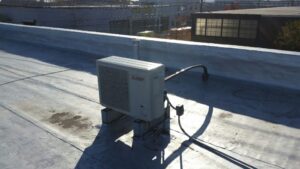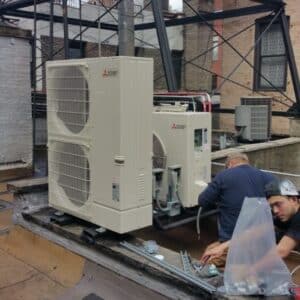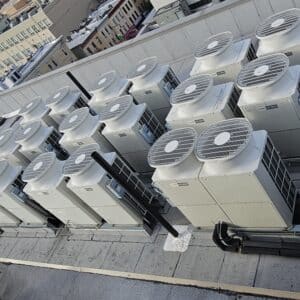To control the environment in your commercial or industrial facility, you need a commercial HVAC system. This type of equipment is specifically designed to handle the complexities associated with heating and cooling a large-scale operation. It’s important to understand how commercial HVAC systems work so you can choose the right one for your needs.

Commercial HVAC Systems Explained
HVAC stands for Heating, Ventilation, and Air Conditioning, and in a commercial application, these components work together to create an HVAC system:
Heating
As the commercial heating system is engaged, combustion gases are created by the system’s burners and moved into a heat exchanger. The air in your commercial space is blown across the heat exchanger, where it’s warmed before being dispersed throughout the building through your ductwork.
Ventilation
Ventilation is a necessary component of any commercial HVAC system, allowing fresh air to enter your commercial building and contaminated air to escape. Without adequate ventilation, the indoor air would become stale, odors would linger, and there would be more mold and mildew growth.
Harmful byproducts created during the combustion process are vented to the outdoors through flues and vent pipes while fresh air is circulated to remove particulates and excess moisture.
Air Conditioning
Air conditioning uses the process of refrigeration to cool the air by removing the heat from it. In addition to lowering the temperature of the air, this process also maintains appropriate humidity levels using a water-cooled or air-cooled system.
Types of Commercial HVAC Systems
There are three main categories of commercial HVAC systems, but countless ways they may be configured, depending on the specific requirements for each building and unique circumstances.
Single-Split System
This popular, affordable option is ideal in smaller commercial applications such as a restaurant, storefront, or small office configuration. A single-split system allows for individualized heating and cooling control for each room, and in larger areas, they can work together to control the environment.

This system will likely be configured to include an air conditioner, furnaces, and an evaporator coil, and it can be controlled using a thermostat or a direct digital control (DDC) system.
THE PROS AND CONS OF A SINGLE-SPLIT SYSTEM INCLUDE:
PROS
- It’s more economical than installing a central HVAC system.
- Each unit operates individually, and if one malfunctions, the others will keep running.
CONS
- Each indoor unit must be connected to a separate outdoor unit, which may conflict with the space restrictions of the commercial facility.
Multi-Split System
A multi-split system works on the same principles as the single-split model with one important difference: up to nine indoor units may be connected to a single outdoor unit. This type of system is often used for larger office spaces, healthcare facilities, and retail stores. It relies on inverter technology, which allows the compressor to operate at variable speeds.

In a more traditional forced-air system, energy is used throughout the day, as the compressor powers on and off each time the unit is engaged in an effort to maintain the desired temperature. With a multi-split system, a lot of energy is conserved as built-in sensors detect minor fluctuations in temperature and make small adjustments as needed.
Pros and Cons of a Multi-Split System
PROS
- Cleaner appearance with fewer outdoor units
- Energy savings
- Choose between wall- or ceiling-mounted cooling
Cons
- Higher cost of installation due to additional pipework and labor
VRF or VRV System
A variable refrigerant flow (VRF) or variable refrigerant volume (VRV) system uses either a heat pump or heat recovery technology. A heat pump system provides either heating or cooling, which may be beneficial for large open areas, whereas a heat recovery system can provide heating and cooling simultaneously and is ideal in applications where the space is divided into multiple rooms.

The Pros and Cons of VRF or VRV Systems:
PROS
- Meets the demands of a large commercial space
- Reliable, efficient, and flexible
- Quick installation
CONS
- Higher upfront costs
- Backup condenser is needed in case the outdoor unit fails
Schedule Commercial HVAC Maintenance in New York City, Manhattan, the Bronx, and Long Island
AFGO is family-owned and -operated, with nearly a century of experience serving customers throughout the New York City area.
Contact AFGO Mechanical at (718) 478-5555 to schedule commercial HVAC analysis for the best ongoing maintenance and support service.


